It Was Good: Performing Arts to the Glory of God edited by Ned Bustard (Square Halo Books) regularly $19.99 ON SALE 10% OFF — $17.99
As most BookNotes readers know, we here at Hearts & Minds are passionate about stocking books that relate historic Christian faith to the complexities of modern life. That includes offering books that can serve as resources for those wanting to serve God well in various spheres of life, in different areas or arenas within society’s many institutions, sub-cultures and neighborhoods. We believe that the God who created the world and who became incarnate in it cares fiercely about our material lives in the world and it seems that we are one of the only Christian bookstores in the country that has whole sections of the shop dedicated to showing off wise and thoughtful books about how live faithfully in various spheres of culture. We stock books on science and architecture and sociology and engineering and economics and art and urban planning and philosophy and sex and farming. From family life to political life, from work to worship, God cares and we enjoy surprising customers by highlighting books that aren’t often found in many religious bookshops: racial justice and mathematics, pop culture and psychotherapy, literature and third world development, environmental science and poetry. We are all called to bear God’s image in this hurting world of wonder and books are tools – and healthy bread for the journey – to help us discover our vocations, honor God in our work, help create a more just society, and a flourishing culture. We love hearing about how our books help followers of Jesus become the salt and light He calls us to be, scattered in every area of life.
We regularly revisit this topic, explaining this holistic “all of life redeemed” theological vision which we and our staff attempt to bring to our task as booksellers, and hope that being reminded of the many different categories and kinds of books offered here – “bearing fresh olive leaves” as our friend Calvin Seerveld allusively put it – might be a blessing.
Of course, as we often have to say, our inventory is not on line — just years of our archived BookNotes newsletter and the many books we celebrate there most still on sale. You can use the website’s inquiry page for any sorts of questions you may have, though, and we can develop lists and suggestions to those who ask, on almost anything. We like to say that we can get almost anything in print.
But there are some books that we get particularly enthusiastic about.
Which brings us to a book that we are very, very happy to announce, a book for which many of us have been eagerly awaiting. It is called It Was Good: Performing Arts to the Glory of God.
It is the third in a series of handsomely created books about the arts, each edited and designed by our friend Ned Bustard. Ned is a Lancaster-based graphic designer and steward of a small indie press, Square Halo Books. Square Halo Books is a publishing venture that is widely respected for doing books about faith and the arts. Although they have published 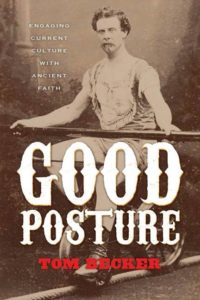 over a dozen books about Christianity and art, and several beautiful art books, they have released a few others not directly about the arts – Deeper Magic: The Theology Behind the Writings of C.S. Lewis by Donald T. Williams, for instance, my own Serious Dreams: Big Ideas for the Rest of Your Life and a pair of books on Genesis and on Revelation (The Beginning and The End.) Revealed: A Storybook Bible for Grownups is remarkable. Another recent one from Square Halo that isn’t exactly on the arts (and that we really, really like) is by Tom Becker, called Good Posture: Engaging Current Culture with Ancient Faith. In many ways it is nearly a gentle, fun, manifesto for their publishing program. We highly recommend it and, like all their other books, are happy to stock it here at the shop.
over a dozen books about Christianity and art, and several beautiful art books, they have released a few others not directly about the arts – Deeper Magic: The Theology Behind the Writings of C.S. Lewis by Donald T. Williams, for instance, my own Serious Dreams: Big Ideas for the Rest of Your Life and a pair of books on Genesis and on Revelation (The Beginning and The End.) Revealed: A Storybook Bible for Grownups is remarkable. Another recent one from Square Halo that isn’t exactly on the arts (and that we really, really like) is by Tom Becker, called Good Posture: Engaging Current Culture with Ancient Faith. In many ways it is nearly a gentle, fun, manifesto for their publishing program. We highly recommend it and, like all their other books, are happy to stock it here at the shop.
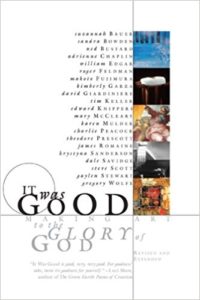 I might suggest, though, that their most important books have been a wonderful pair called It Was Good: Making Art to the Glory of God and It Was Good: Making Music to the Glory of God. Both bring together theorists and practitioners to reflect on some important aspect about the art and practice of doing faith-inspired art. In both, they’ve had contributions from well-known writers (Timothy Keller, Sandra McCracken, Gregory Wolfe, Makoto Fujimura) and many who are not known outside of their particular field of expertise but are excellent in what they do. To curate such edited volumes has been both a challenge and a joy for Ned as it is no small matter finding artists and musicians who are theologically mature, good at their craft, who have been intentional about thinking about how they integrate faith and art, and who can actually describe and write about their own particular
I might suggest, though, that their most important books have been a wonderful pair called It Was Good: Making Art to the Glory of God and It Was Good: Making Music to the Glory of God. Both bring together theorists and practitioners to reflect on some important aspect about the art and practice of doing faith-inspired art. In both, they’ve had contributions from well-known writers (Timothy Keller, Sandra McCracken, Gregory Wolfe, Makoto Fujimura) and many who are not known outside of their particular field of expertise but are excellent in what they do. To curate such edited volumes has been both a challenge and a joy for Ned as it is no small matter finding artists and musicians who are theologically mature, good at their craft, who have been intentional about thinking about how they integrate faith and art, and who can actually describe and write about their own particular 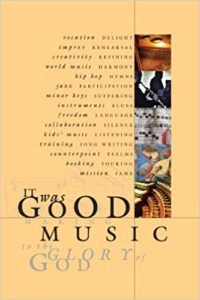 experiences in the arts. Some painters or musicians do their work very, very well, but are not particularly adept at talking about it, let alone writing a chapter inviting others to learn or take inspiration from them. And, sadly, as with the books integrating Christian thinking about other professions, there just isn’t the demand for these kinds of books that there should be. As you can imagine, It Was Good volume one and volume two were both labors of love, and both are, thankfully, absolutely must-have resources for anyone remotely interested in the creative arts. Alongside a handful of others, they are modern-day classics in the genre of theologically informed aesthetic vision that can inform our own appreciation of the arts.
experiences in the arts. Some painters or musicians do their work very, very well, but are not particularly adept at talking about it, let alone writing a chapter inviting others to learn or take inspiration from them. And, sadly, as with the books integrating Christian thinking about other professions, there just isn’t the demand for these kinds of books that there should be. As you can imagine, It Was Good volume one and volume two were both labors of love, and both are, thankfully, absolutely must-have resources for anyone remotely interested in the creative arts. Alongside a handful of others, they are modern-day classics in the genre of theologically informed aesthetic vision that can inform our own appreciation of the arts.
You can read my lively BookNotes reviews of IWG: Making Art HERE and IWG: Making Music HERE.
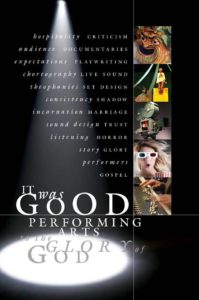 The brand new It Was Good: Performing Arts to the Glory of God is unlike any other book on the market so it would be a great gift for anyone you know who is in, or aspires to be in, the world of the performing arts.
The brand new It Was Good: Performing Arts to the Glory of God is unlike any other book on the market so it would be a great gift for anyone you know who is in, or aspires to be in, the world of the performing arts.
IWG number three includes 22 easily read chapters and is arranged in a format similar to the previous two. That is, there are somewhat allusive chapter titles that seem to correspond with (often) one-word themes. For instance, there is a chapter on hospitality, one on listening, another few on story, and a useful one on expectations. These are helpful for anyone – who couldn’t stand to be reminded of how to trust God more in a chapter that starts with an actor crying in a dressing room when she learned that she didn’t get a part she had hoped for? Although many of these chapters are fairly simple, with commonplace wisdom, they are firstly written to and for other performing artists which suddenly makes them a gift of great grace, especially for those starting out in their work in the performing arts. One great chapter on marriage is written by a woman in theater whose husband is a traveling musician; as one who works with his spouse in a family business, I found the chapter very helpful. The opening chapter by Ned Bustard on what it means that we are to live for God’s glory is, again, while designed for artists, obviously, is general and insightful enough that it would be well worth reading for any of us. His opening story of a young cellist in his church and her fear that she wasn’t able to glorify God in her musical endeavors is telling, and his apologetic for God-glorifying art and culture and living is well worth reading more than once.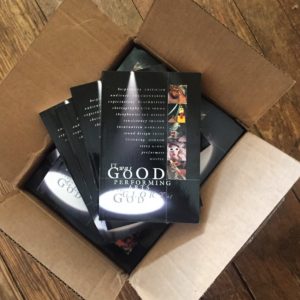
If some of the chapters are light and nicely inspiring a few are very good in their mature expositions of the calling of artists. Ransom Fellowship’s Denis Haack has a fabulous rumination on story (as a way of describing the allure and importance of contemporary film.) After quoting a line by a critic in The Atlantic, who said “Fiction can briefly offer the assurance of things hoped for, the conviction of things not seen,” Haack writes:
To live in a world populated by creatures made for story, the calling to be a storyteller is a high calling, indeed. Making good films is a spiritual act, pleasing to God even if there isn’t a single religious thing, narrowly defined, in the film.
There are two pieces by sound engineers—on one the splendor of sound recording (you will never skip that part of the Academy Awards again!) and the other by a guy who works the soundboard at live concerts. One of the very best chapters is on “incarnation” and offers a theology of acting among “exploited image bearers.” It is very impressive that there is a chapter by classical dancer Jenifer Ringer, who had a best selling memoir of her work and struggles with the New York City Ballet, Dancing Through It: My Journey in the Ballet. I really liked the two pieces on horror, one by the impressive screenwriter Brian Godawa. Brian Chan’s chapter about monsters explains how “the pained villain speaks to our humanity.” Again, this stuff will be very useful to those working in the film industry, say, or who are dancers or actors. But I think those of us who are not professionals or working in the arts will certainly enjoy them. I sure did.
For instance, I was very moved by an excellent chapter on “consistency” by an actress in New York, Elizabeth Richard. (She happens to be a Tony Award nominee.) As she told the story of Estelle Getty, who played Sophia on The Golden Girls and garnered numerous Emmy nominations, and of an enduring producer she has worked with and even the long, hard work of Nobel Prize wining playwright George Bernard Shaw, I was strangely inspired. (She also referred back to a story in It Was Good: Making Art to the Glory of God which indicates she’s done some of the reading and thinking so necessary to be faithful in this arena.) Also, I was very, very impressed with a captivating chapter about stage and set design. Marlaina Seay’s emphasis on sin was almost a bit heavy-handed but her obvious joy in creating appropriate mood-enhancing lines and spaces with just the right lighting and color had beautiful hints of redemption, making it one of the strongest pieces in the collection.
If anyone needs a book that often speaks clearly to those who might, for stuffy theological reasons, have doubts about the performing arts, know that most of these authors are theologically conventional and obviously involved in evangelical church life. There is no lack of piety and nothing inappropriately edgy or odd. One of the early chapters describes a “green room” ministry that artists can have doing quiet evangelism and mentoring among other performers. One great piece on performance itself starts with an episode that will seem odd to non-fundamentalists, when one pastor worried about too much inflection and drama in how someone read the Scripture in church! These essays ought not be off-putting to more mainline denominational or ecumenical readers – in fact, perhaps the strongest piece in the book includes a serious (Reformed Protestant) study of Pope John Paul II’s important and generative “Theology of the Body” and its implications for artists and actors, particularly. Penned by Camille Hallstrom, who founded the theatre department at Covenant College, it is very, very good. Entitled “Dignity” and exploring the imago dei,it is perhaps the most important chpater for actors and actress in the whole book, exploring profound ethical and artistic matters of what to do on stage. It even ends with flourish, sharing a poem by former Minister of Culture in Nicaragua, Ernesto Cardenal.
The back few pages that offer the biographies, resumes, and professional accomplishments of the contributing authors is itself an amazing read – the qualifications of most of those writing here are top-shelf. They have mixed sound with expert recording artists, they have premiered plays in prestigious locations, they have danced with the best ballets in the world, they have made award- winning documentaries. There is a house manager of a major playhouse, there are those who have worked on well-known TV shows, there are those who teach in well-respected university departments. Whether one is drawn to the stage or enjoys serious TV, whether one is a dancer or a film-maker or actress, there is something in this book for you. Like its first two predecessors, It Was Good: Performing Arts to the Glory of God is a rare resource and a great read.
Two very impressive pieces bookend It Was Good: Performing Arts for the Glory of God. The first is a short foreword exclaiming how very useful this book is, written by David H. Kim, the Director of the Center for Faith and Work of Redeemer Presbyterian Church in New York City. (David helped edit the Faith and Work Study Bible, in fact, and brings his deep Kuyperian worldview to bear in ministry with Manhattan business people, educators, professionals of all kind, including, of course, artists.) He suggests that although this book is designed to help artists relate their faith in meaningful ways to their calling in their performing careers or avocations, it is also important for all of us. To be schooled in caring about aesthetics and the arts and the value of performance and the practical life of artists is itself a good thing for us all.
Kim writes:
Square Halo has done the church a great service. With each chapter, you will encounter the creativity and craft of those involved in various aspects of the performing arts. Through each chapter, my hope is that you will discover the reality of a Gospel that awakens the church to see the passing brokenness of this world through renewed eyes. A church that grasps the reality of pervasive grace is one that is compelled to bring hopeful works into all aspects of our world. Our current culture is in desperate need of just this kind of witness.
David ends his lovely essay where he began, describing the impact the performing arts can have:
I hope you will engage the performing arts and that through those experiences your growing attentiveness to our world will allow you to see that despite the tragedy of its brokenness there remains the glorious promise of unimaginable renewal.
The closing chapter of the book is one of the very finest. It is by an increasingly well-known film critic, Alissa Wilkinson, now a culture reporter and film critic at Vox.com. It is a wonderful piece, well written, as you would expect, and illustrating the profound sort of perspective that she has developed on her task as critic. She starts with a look at the negative reputation of the critic by noting the “skinny, sour-faced restaurant critic” Anton Ego from Pixar’s Ratatouille, and the way in which film critic Pauline Kael famously destroyed director David Lean’s confidence and career after his Bridge on the River Kwai.
“But is this the only path for the critic?” she asks. Can the critic actually have her work properly directed by love? Can the good critic help build culture rather than tear it down?
Wilkinson’s insights are profound here as she offers her reflections on “horizons, gestures, and postures.” She is channeling a bit of Andy Crouch’s Culture Making, and James K.A. Smith (as she did somewhat in the co-authored book How to Survive the Apocalypse about the political implications of zombies, et al.) and it makes for a particularly thoughtful, insightful contribution.
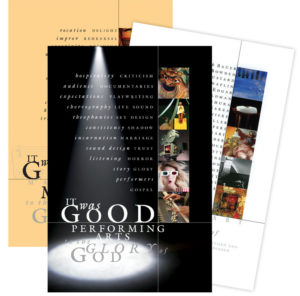 Square Halo Books is to be commended putting out these good books. Kudos to Mr. Bustard for the behind-the-scenes work of nurturing relationships with so many artists in so many fields from so many venues which has borne fruit in this series of three It Was Good books. The bibliography in the back of this new one is thorough, but not exhausting, listing only the very best faithful scholars (of the likes of Jeremy Begbie, Calvin Seerveld, Madeline L’Engle, Cameron Anderson, Steve Turner, Sandra Bowden, William Edgar, Dorothy Sayers, and the like.) making it an ideal reference tool.
Square Halo Books is to be commended putting out these good books. Kudos to Mr. Bustard for the behind-the-scenes work of nurturing relationships with so many artists in so many fields from so many venues which has borne fruit in this series of three It Was Good books. The bibliography in the back of this new one is thorough, but not exhausting, listing only the very best faithful scholars (of the likes of Jeremy Begbie, Calvin Seerveld, Madeline L’Engle, Cameron Anderson, Steve Turner, Sandra Bowden, William Edgar, Dorothy Sayers, and the like.) making it an ideal reference tool.
David Kim is right – Mr. Bustard has given a great gift to God’s people. Many others have also offered very cool rave views of IWG: Performing Arts… Scholar and professor William Edgar (himself a jazz pianist) says it is “must reading for anyone hoping to understand how the arts work for a Christian perspective.” Max McLean writes, “This is a wise book written by experienced practitioners who have been in the trenches of creating art from a Christian worldview. It ain’t easy, and if you want to try it, I suggest you read this book.”
Image journal’s Gregory Wolfe gives a “standing ovation.” And isn’t that what any performing artist hopes for? All I can ad is “encore, encore!
BookNotes

SPECIAL
DISCOUNT
ANY ITEM MENTIONED
10% Off
order here
this takes you to the secure Hearts & Minds order form page
just tell us what you want
inquire here
if you have questions or need more information
just ask us what you want to know
Hearts & Minds 234 East Main Street Dallastown PA 17313
read@heartsandmindsbooks.com
717-246-3333
